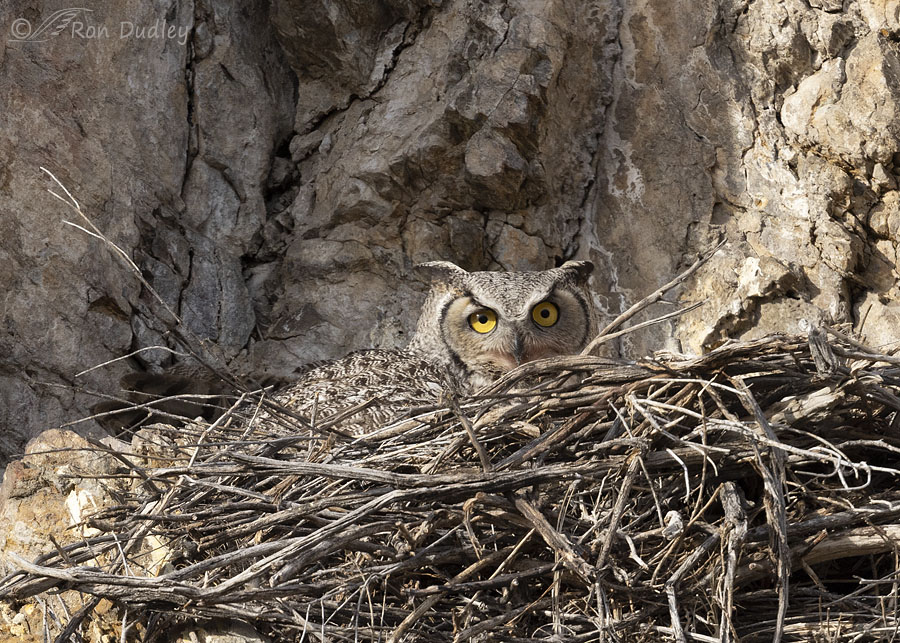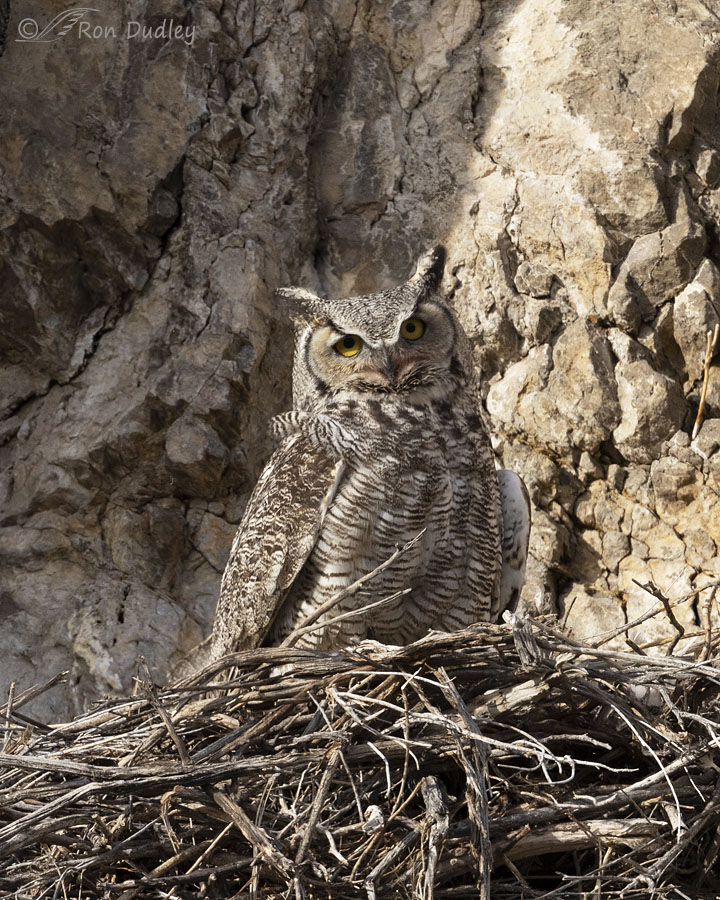Only the second time I’ve photographed a nesting Great Horned Owl in a completely natural setting and it happened yesterday morning..

1/2000, f/7.1, ISO 800, Canon R5, Canon EF500mm f/4L IS II USM + 1.4 tc, not baited, set up or called in
In Great Horned Owls only the female incubates eggs and broods chicks so this bird is almost certainly a female. That belief was reinforced by my perception of her size. I never did see the male.
She spent most of her time with her head down and her eyes closed (or nearly so) but when a squawking raven flew by it got her attention and that’s when I took this photo. Immediately after she relaxed again.

1/2500, f/7.1, ISO 800, Canon R5, Canon EF500mm f/4L IS II USM + 1.4 tc, not baited, set up or called in
I was surprised when she stood up like this for a moment but her motivation soon became apparent. Only seconds after this photo was taken she took off to her left after prey. She landed less than 100′ from the nest and stayed there for less than 15 seconds before returning to the nest but I couldn’t tell if she had prey in her talons. If she did it was most likely a vole. And no, I didn’t get any takeoff, flight or landing shots that I like.
When I’ve photographed nesting Great Horned Owls in the past, with only one exception their nest has always been in a nest box, old granary or other manmade structure, so finding this one in a completely natural setting was a delight.
Ron
Note: I won’t make my readers endure all the details (you’ve had to read them in the past, many times) but rest assured, this nesting owl was photographed ethically.


I have a Great Horned Owl living in a tree in my yard. The nest is right above by bedroom. The took over a crowns nest, its been such a delightful experience having them around. The male comes back ever night and they hoot at each other. One egg dropped from and a baby died it was nearly newborn- all white. I buried it under a tree close by and put a white rock on top of the grave. Ive taken out my 18 yr old digital camera I got after I graduated college college and captured a few cool photos of the make during sunrise. Beautiful, intelligent, majestic beings!
What lovely pictures. I currently have a Great Horned Owl living around my home in Ogden, I’m on the east bench. I’m not sure if it’s male or female. Every evening, as the sun starts to set, there it is. I’ve seen it sleep in one of my pine trees next to my home. I love listening to it hoot, morning and evening. It’s welcome to make it’s home around my house, it must feel safe. That makes my heart smile.
Beautiful mother owl! 60 years ago when I was in school I volunteered at a natural history museum. One of my jobs was dusting stuffed birds. I dusted a Great Horned and a Great Gray Owl. I recall them being HUGE. Of course I was only about 12 and barely 4 ft 6 inches tall! +
Thanks, Susan. I used to work at a natural history museum too. Good memories. In fact, I ran into a museum employee this morning while I was out shooting birds. We had an enjoyable visit.
Your first shot has me speechless! The owl in her natural nest is such a delight!
Thanks very much, Kathleen.
Nice find and images. In my area they like to nest in old raven and hawk nests. It can be a problem often they are In billboard, street signs and building faces. When the birds fledge it is into busy streets.
Thanks, April.
What a WONDERFUL find, for you and for us. Megathanks.
Thank you, EC.
Now that’s an Easter treat if ever there was one — what a glorious find! Her nest does look suspiciously like a RTHA creation. In any case, I’m glad she and her mate have found a safe location to raise their family and that you are able to photograph it from a safe location. Looking forward to bobbleheads in the not-too-distant future!
Chris, here’s what Cornell has to say about the original builder of the nests that Great Horned Owls take over: “Depend on initial builder of nest, most commonly Red-tailed Hawks, other hawks, and nests of crows, ravens, herons, and squirrels.”
Oh, so beautiful! My first reaction was confusion about the nest – it looks like one of the RTH nests you’ve shown us recently. Recycling at its best!
We’ve got a GHO pair in our neighborhood – heard, not seen. Hooting back and forth at 2am. He’s close, staying put, she’s far away, moving around. Really magical.
Carolyn, you sound pretty good natured to be regularly awakened in the middle of the night and be happy about it. But a hooting owl beats the hell out of a yowling cat outside your bedroom window.
Nice photos Ron. I would never think you took any photos unethically. When we had a nest in nearby woods that eventually produced two very healthy GHOs I often saw the male bringing them prey. And then later as they grew larger and were out of the nest I saw her bringing them gophers. Was really interesting to watch.
Thanks, Eveett. “Gophers” (Richardson’s Ground Squirrels) are almost the only thing the owls on the Montana farm eat. They’re everywhere up there. I’m pretty sure these owls are eating mostly smaller rodents.
I don’t know which came first: you’re ability to find birds so you decided to start photographing them, or you took up photography and then developed your bird finding skills. Either way it’s a helluva combination. The proof is in these and pretty much all your posts.
It’s the latter, Lyle. I started photographing them way before I became good at finding them. Developing the skill takes a long time.
I always trust your photography methods to be ethical, it has never been a bother to read the assurances you offer, I think it is useful to anyone who may have freshly joined your blog to become familiar with you and one of the many reasons your readers remain as supporters of your honest and enthusiastic blog. I’d have to agree with you, I have not seen anyone photograph an owl in an open style nest vs what might be perceived as under the protections the other nesting sights might offer. You have become the eagles’ eye spotting this one. Glad the climate is clearing for spring shots.
Thanks for your faith in me, Deb. For me it’s a balancing act between letting my readers know that shots like these were taken ethically and saying it so often they get sick of reading it.
You might link to a post where you’ve discussed your ethics where bird photography is concerned. That way you can…explain two birds with one stone! (That’s a TERRIBLE analogy!)
What perfect camouflage the rocky surround makes for her and the owlets-
to-be…….it’s a tribute to your eye that you spotted her–great capture ! I
hope that in the near future you will get some images of her and her brood…..
“hope that in the near future you will get some images of her and her brood”
I hope so too, Kris. It’s been a while since I’ve photographed GHOW youngsters.
She’s a beauty. Got to hold my first GHOW baby of the season last week, who has hopefully been returned to his (or a foster) nest by now. I guess we’re a bit ahead of you here in Maryland, where it’s been an early spring.
For us it’s been a very late and cold spring, Cathy. Spring weather didn’t even start until a couple of days ago. It’s here now though.
Awesome birds. Seeing photos of one in the daylight is a treat. What a great find Ron!
Many years ago I spotted a Great Horned Owl nest while walking through a eucalyptus grove on the CSUN campus here in the San Fernando Valley. Actually, I first spotted the mass of droppings, castings, and dismembered Raven wings and such scattered around the base of one of the trees. I looked and about 40 feet up were three owlets looking down at me, heads bobbing in that curious way that they do. It was the one and only time I saw a Great Horned Owl nest. Unforgettable.
Sounds like you’re a pretty good bird sleuth, Michael. A lot of folks would never have noticed, or even paid attention.
Oooh! She’s lovely! I wonder whose nest she’s “squatting” in — for some reason, I’m thinking RTHA. If I can anthropomorphize the 2nd shot, I’m imagining her saying, “OK, Ron. Get it over with. Just take the damn picture already.”

And as always, thank you for your ethics.
Marty, red-tail nests are the most common nests they use but they’ll use the nests of other species too.
Neat! Catching them on the next here is next to impossible as they are usually in an old Maggpie nest WAY up it a tree. Must be an old hawk nest as, to my knowledge, they don’t really build their own. We haven’t had any in the yard in several years – I miss them.
It does appear she’s been eating from the redish around her mouth.
57 degrees out at 5: a.m. – WAY too warm for this time of year. In theory it will cool down some again by about Wed.
In theory it will cool down some again by about Wed.
You’re right, Judy – they don’t build their own nests. And I don’t think she’s going hungry. To me she looked plump and healthy.